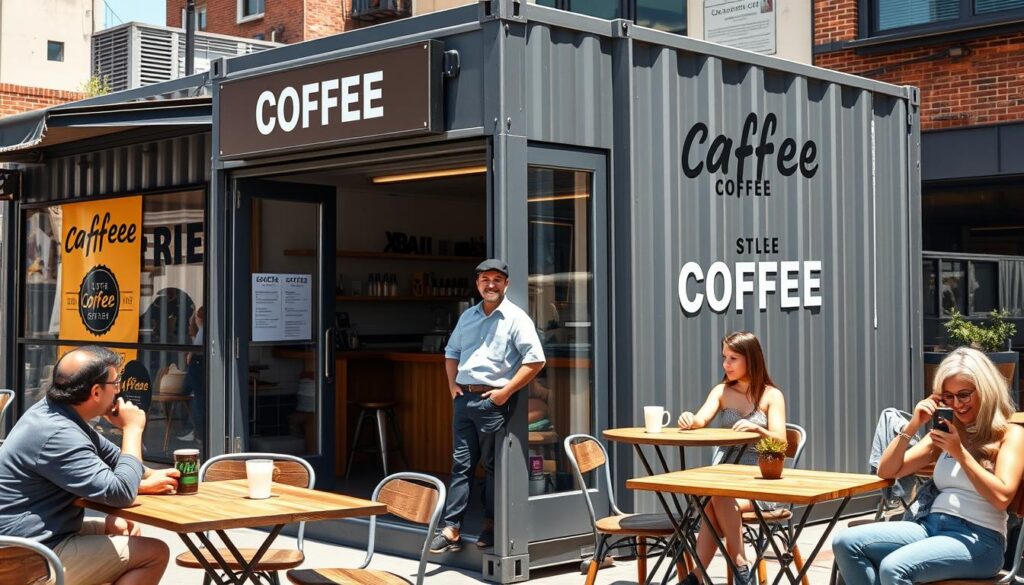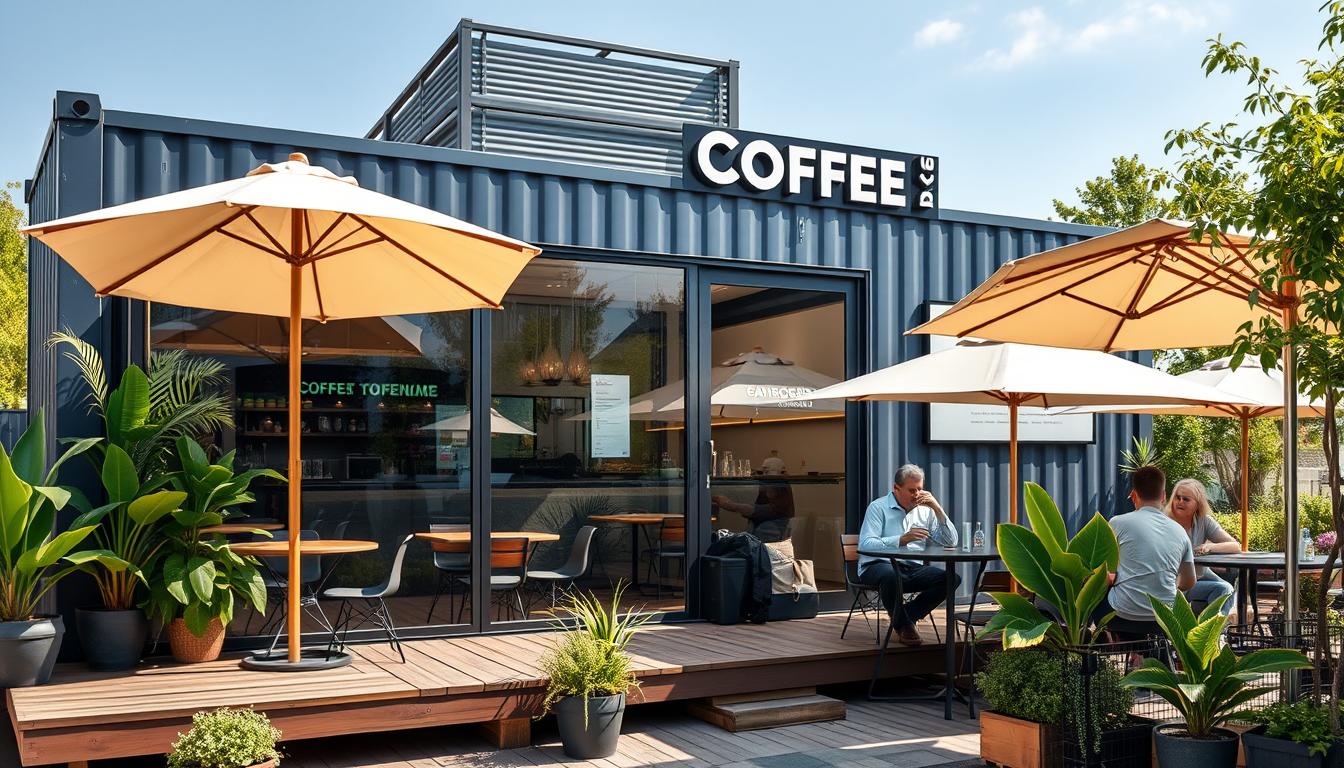The humble shipping container has evolved from mere transportation vessel to architectural marvel, with container coffee shops leading this revolution. These innovative spaces combine sustainability, mobility, and distinctive design to create unforgettable customer experiences. Whether you’re an aspiring entrepreneur or a coffee enthusiast with big dreams, shipping container coffee shops offer a unique pathway into the café business with lower startup costs and greater flexibility than traditional brick-and-mortar establishments.
Why Choose a Shipping Container for Your Coffee Shop?
Before diving into design ideas, let’s explore why shipping containers have become the go-to choice for innovative café owners worldwide. These steel structures offer numerous advantages that traditional buildings simply can’t match.
Cost-Effective Solution
Starting a traditional café can require significant capital investment. Container coffee shops typically cost 20-30% less than conventional construction, with prices ranging from $25,000 to $100,000 depending on size and customization. This lower entry barrier makes entrepreneurship accessible to more people.
Sustainability Champion
Repurposing shipping containers gives these steel boxes a second life, reducing waste and environmental impact. Many container cafés enhance their eco-credentials further with solar panels, rainwater collection systems, and energy-efficient appliances, appealing to environmentally conscious customers.
Unmatched Mobility
Perhaps the most compelling advantage is mobility. Unlike traditional cafés, container coffee shops can relocate to chase seasonal crowds, test different neighborhoods, or participate in events. This flexibility reduces the risk of being tied to a poor location and allows for business model evolution.
“The global shipping container market size was valued at $8.70 billion in 2019 and is projected to reach $12.08 billion by 2027, with container cafés representing one of the fastest-growing segments in this industry.” — Allied Market Research
12 Inspiring Shipping Container Coffee Shop Ideas
From minimalist modern designs to rustic charm, shipping container coffee shops offer endless creative possibilities. Here are twelve distinctive concepts to spark your imagination.
1. Minimalist Urban Oasis
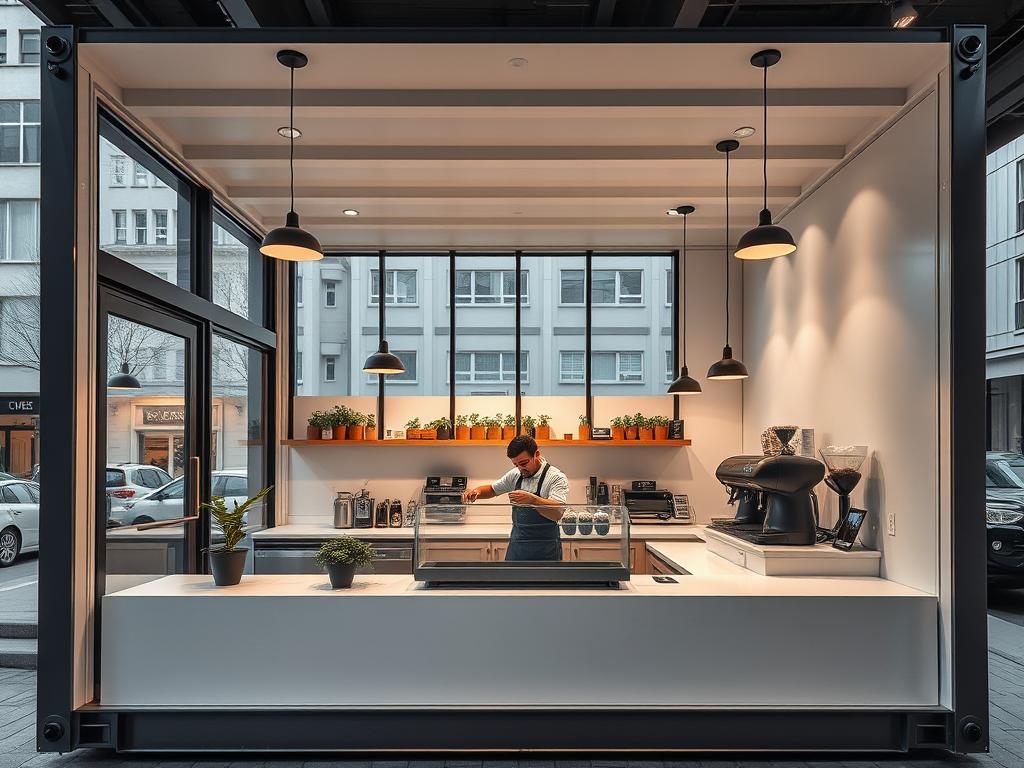
Embrace the industrial-chic aesthetic with a minimalist design featuring clean lines, neutral colors, and uncluttered spaces. This approach makes your café feel larger and creates a calm environment where customers can escape the urban hustle. Key elements include built-in seating, multi-functional furniture, and strategic lighting to enhance the sense of space.
2. Rustic Countryside Retreat
Transform your container into a cozy haven with reclaimed wood paneling, vintage furnishings, and warm lighting. This rustic approach creates an inviting atmosphere that encourages customers to linger. Complement the design with outdoor seating surrounded by greenery to create a peaceful escape that harmonizes with natural surroundings.
3. Tropical Paradise
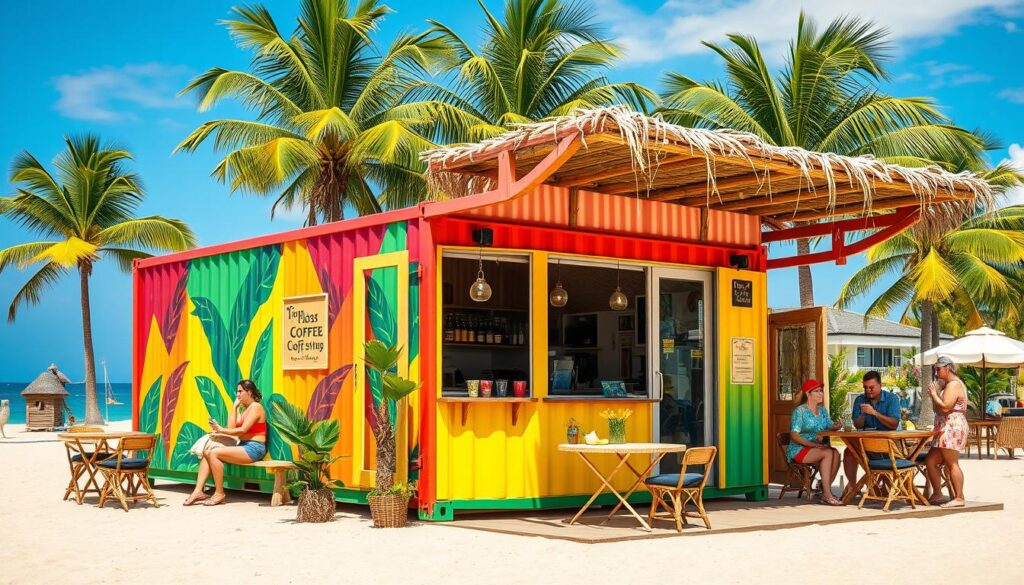
For beachside or resort-adjacent locations, a tropical-themed container café creates an instant vacation vibe. Incorporate vibrant colors, exotic plants, and natural materials like bamboo and rattan. Open-air designs with retractable walls maximize the connection to the outdoors, while ceiling fans and shade structures ensure customer comfort.
4. Industrial Warehouse Vibe
Celebrate the container’s industrial origins with exposed metal surfaces, concrete countertops, and visible structural elements. This raw, edgy aesthetic appeals particularly to urban millennials and Gen Z customers. Enhance the atmosphere with Edison bulbs, metal fixtures, and a coffee roasting station where customers can watch the bean-to-cup process.
5. Vintage Nostalgia
Create a time-capsule experience with retro design elements from a specific era. Think 1950s diner aesthetics with checkerboard floors and chrome accents, or 1970s vibes with earthy tones and macramé decorations. Vintage furnishings, antique coffee equipment displays, and era-appropriate music complete the immersive experience.
6. Artistic Expression

Turn your container into a canvas by commissioning local artists to create stunning murals on the exterior. Inside, continue the artistic theme with gallery-style lighting, rotating art exhibitions, and creative furniture pieces. This approach positions your café as a cultural hub and creates Instagram-worthy moments that drive social media exposure.
7. High-Tech Coffee Lab
Appeal to coffee connoisseurs with a laboratory-inspired design featuring sleek, minimalist interiors and cutting-edge brewing equipment. Glass partitions allow customers to watch specialized brewing methods, while digital menus and ordering systems streamline the experience. This concept works particularly well in tech hubs and university areas.
8. Coastal Breeze
For waterfront locations, a nautical-themed container with large windows maximizing ocean views creates an irresistible draw. Blue and white color schemes, weathered wood, and maritime decorative elements enhance the coastal feel. Rooftop or deck seating allows customers to fully appreciate the surroundings while enjoying their coffee.
9. Retro Diner

Recreate the classic American diner experience with booth seating, checkerboard patterns, and a service counter with swivel stools. Add nostalgic touches like a jukebox, neon signage, and staff uniforms that complement the theme. This familiar, comfortable environment appeals to a wide demographic and creates a strong brand identity.
10. Artisanal Craftsman
Showcase natural materials and handcrafted elements with an artisanal design approach. Incorporate handmade ceramic tiles, custom woodwork, and textured surfaces that highlight craftsmanship. This aesthetic pairs beautifully with an emphasis on manually brewed coffee and locally sourced ingredients, creating a cohesive brand story.
11. Garden Oasis
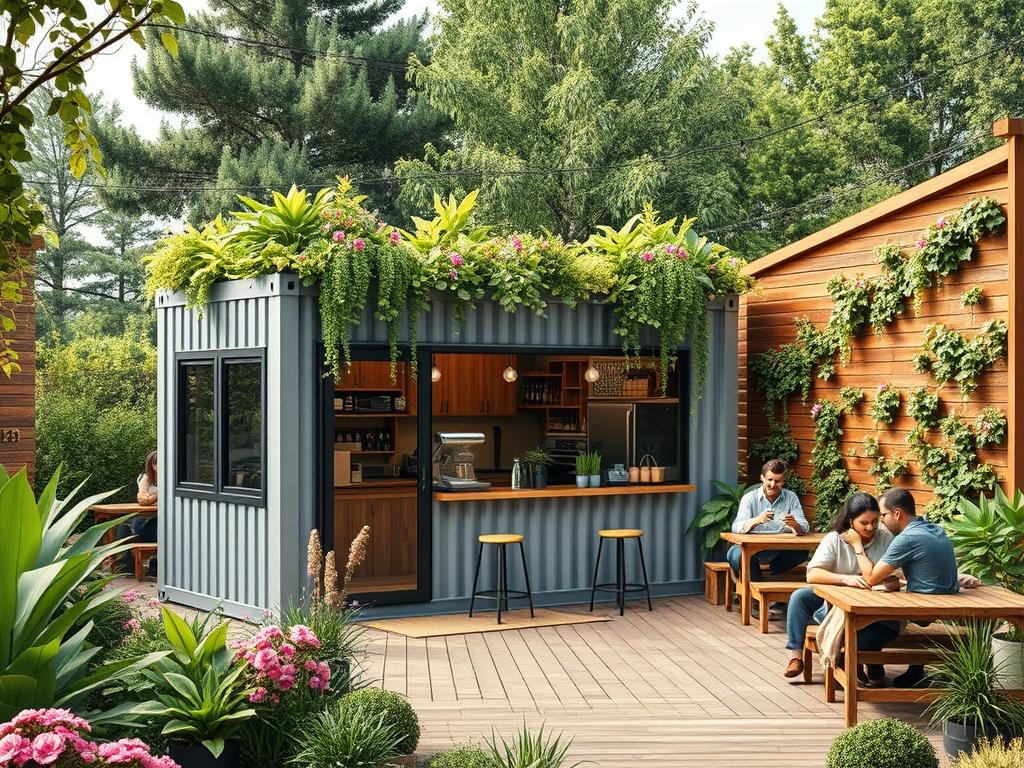
Integrate your container café into a garden setting with a green roof, living walls, and abundant surrounding plantings. This biophilic design approach creates a restorative environment where customers can connect with nature. Herb gardens can provide fresh ingredients for beverages, strengthening your sustainability credentials.
12. Urban Night Spot
Design your container to transition from daytime café to evening hangout with adaptable lighting, convertible furniture, and a versatile menu that includes coffee cocktails. Dark exterior colors with strategic illumination create a sophisticated nighttime presence, while sound systems and potential rooftop space can accommodate small performances or DJ sets.
Choosing the Right Container Size for Your Coffee Shop
Container size significantly impacts your café’s layout, capacity, and functionality. Here’s a comparison of common options to help you make an informed decision:
| Container Size | Dimensions | Seating Capacity | Best For | Approximate Cost |
| 10ft Container | 10′ x 8′ x 8.5′ | 0-4 customers | To-go service, kiosks, pop-ups | $20,000-$35,000 |
| 20ft Container | 20′ x 8′ x 8.5′ | 8-12 customers | Small cafés with limited seating | $35,000-$65,000 |
| 40ft Container | 40′ x 8′ x 8.5′ | 15-25 customers | Full-service cafés with seating | $65,000-$100,000 |
| 20ft High Cube | 20′ x 8′ x 9.5′ | 8-12 customers | Cafés needing extra vertical space | $40,000-$70,000 |
| Double-Wide (2x20ft) | 20′ x 16′ x 8.5′ | 20-30 customers | Larger cafés with separate zones | $80,000-$120,000 |
Many successful container cafés combine multiple units or incorporate outdoor seating to expand capacity beyond what the container alone can provide. Consider your location’s climate, available space, and expected customer volume when selecting your container size.
Success Stories: Container Coffee Shops That Got It Right
Learning from established container cafés can provide valuable insights for your own venture. Here are three success stories that demonstrate different approaches to the container coffee shop concept.
Ritual Coffee Roasters (San Francisco, CA)
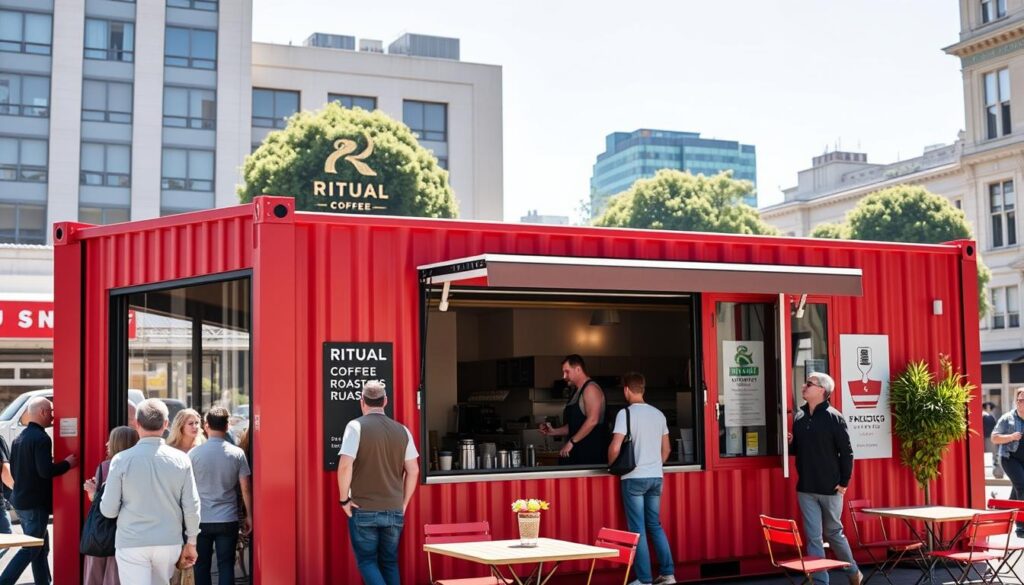
This pioneering container café transformed a vacant lot into a thriving community hub. Using a single 20ft container with a large service window, Ritual created an efficient operation focused on quality coffee rather than extensive seating. Their bright red container became an iconic landmark, demonstrating how bold branding and strategic location can overcome space limitations.
The Grounds (Sydney, Australia)
Taking a different approach, The Grounds incorporated multiple shipping containers into a larger complex that includes gardens, seating areas, and event spaces. Their containers serve specialized functions—one houses the main coffee bar, another operates as a bakery, and a third provides educational workshops. This modular approach allowed for phased expansion as the business grew.
Starbucks Reclamation Drive-Thru (Seattle, WA)

Even coffee giants recognize the appeal of container architecture. Starbucks created this LEED-certified store using four reclaimed shipping containers, showcasing how the concept can scale to meet corporate standards. Their design incorporated a drive-thru window and walk-up service counter, proving that container cafés can accommodate different service models.
What these success stories share: strategic location selection, distinctive branding, efficient use of limited space, and a clear understanding of their target customers’ needs and preferences.
How to Start Your Shipping Container Coffee Shop: A Step-by-Step Guide
Turning your container café dream into reality requires careful planning and execution. Follow these essential steps to navigate the process successfully.
- Research and Planning – Conduct market research to identify your target audience, competition, and potential locations. Develop a comprehensive business plan including financial projections, marketing strategy, and operational procedures.
- Secure Financing – Calculate startup costs and secure necessary funding through personal investment, loans, grants, or investors. Be sure to include container purchase, modification costs, equipment, permits, and operating capital.
- Location and Permits – Find a suitable location with appropriate zoning for a food service business. Research local regulations regarding health department requirements, building codes, and specific rules for container structures.
- Container Selection – Choose between new (“one-trip”) or used containers based on your budget and quality requirements. Inspect thoroughly for structural integrity, especially if purchasing used.
- Design and Modification – Work with an architect or container modification specialist to design your space. Consider kitchen layout, customer flow, utilities, insulation, and aesthetic elements.
- Utility Installation – Plan for electrical, plumbing, HVAC, and ventilation systems. These modifications require professional installation to meet code requirements and ensure safety.
- Equipment and Furnishings – Select commercial-grade coffee equipment, refrigeration, storage solutions, and furnishings that maximize your limited space while creating the desired atmosphere.
- Staffing and Training – Hire and train staff with an emphasis on efficiency in a compact workspace. Develop procedures that optimize movement and service in the container environment.
- Marketing and Launch – Build anticipation through social media, local press, and community engagement. Plan a grand opening event that showcases your unique container concept.

Maintaining Your Container Coffee Shop
Proper maintenance ensures your shipping container café remains attractive, functional, and compliant with health regulations. Here are key considerations for long-term success:
Structural Maintenance
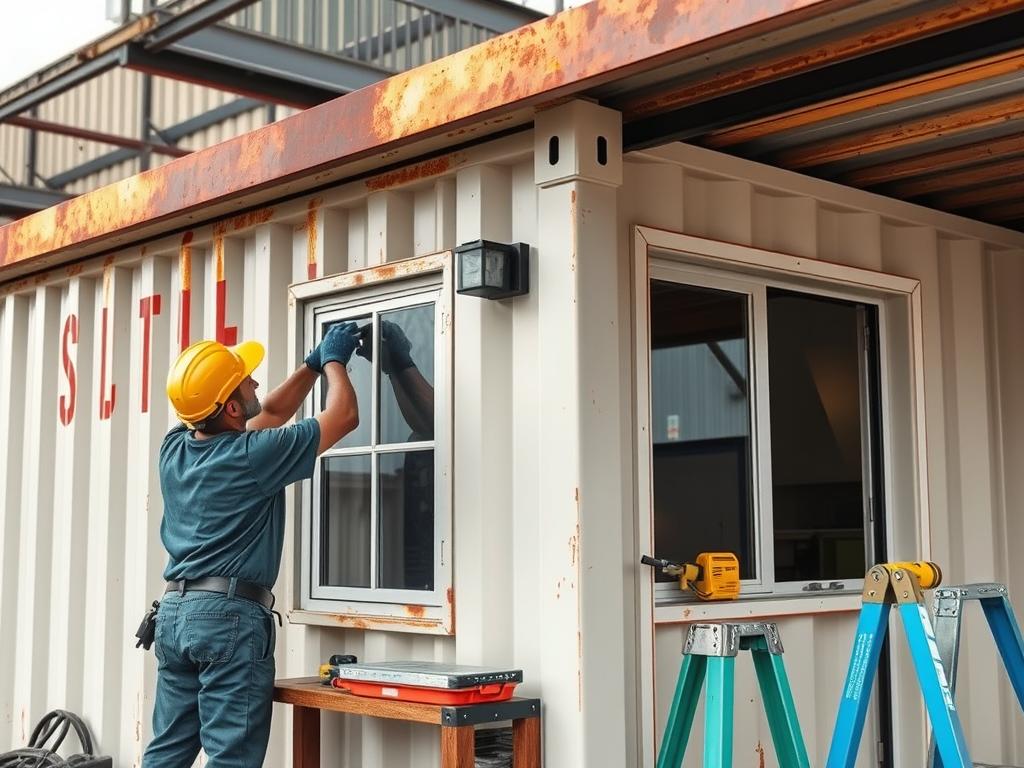
Shipping containers are durable but require regular attention to prevent issues:
- Inspect for and treat rust spots quarterly, especially in coastal or humid locations
- Check roof seams and corner castings annually for water intrusion
- Maintain exterior paint or cladding to protect the metal structure
- Examine floor integrity, particularly in high-traffic areas
Climate Control Systems
Metal containers respond quickly to temperature changes, making climate control essential:
- Service HVAC systems seasonally to ensure efficient operation
- Clean or replace air filters monthly
- Check insulation integrity annually, looking for condensation or moisture damage
- Consider adding awnings or shade structures to reduce solar heat gain
Plumbing and Electrical
The compact nature of container cafés makes utility maintenance particularly important:
- Inspect plumbing connections quarterly for leaks or corrosion
- Test greywater systems monthly if your setup includes them
- Have electrical systems professionally inspected annually
- Check ground fault protection regularly in wet areas
Health and Safety Compliance
Maintaining health department compliance requires ongoing attention:
- Schedule regular pest control services
- Clean ventilation hoods according to usage (typically quarterly)
- Maintain accurate cleaning logs for health inspections
- Update safety equipment including fire extinguishers and first aid kits
Creating a comprehensive maintenance calendar with daily, weekly, monthly, and annual tasks will help prevent costly emergency repairs and extend the life of your container café.
Frequently Asked Questions
What permits do I need for a shipping container coffee shop?
Permit requirements vary by location but typically include:
- Business license
- Food service permit
- Building permit for modifications
- Health department approval
- Certificate of occupancy
- Signage permits
Some jurisdictions have specific regulations for container structures, so consult with local authorities early in your planning process. Many successful container café owners recommend hiring a permit expediter familiar with non-traditional structures.
How do I properly insulate a shipping container for a coffee shop?
Proper insulation is crucial for energy efficiency and comfort. The most common approaches include:
- Spray foam insulation – Provides excellent thermal barrier and seals gaps but is more expensive
- Rigid foam board – Cost-effective and easy to install but requires careful sealing
- Wool insulation – Eco-friendly option with good acoustic properties
Most container cafés use a combination of insulation methods, with spray foam for the ceiling, rigid panels for walls, and additional floor insulation. Always include a proper vapor barrier to prevent condensation issues, and ensure your insulation plan accounts for climate control systems and utility runs.
How much does it cost to convert a shipping container into a coffee shop?
Conversion costs vary widely based on:
- Container size and condition ($1,500-$5,000 for the container itself)
- Extent of modifications ($15,000-$30,000 for basic structural changes)
- Quality of finishes and equipment ($10,000-$50,000)
- Utility connections ($5,000-$15,000)
- Professional services (design, engineering, permits: $5,000-$15,000)
A basic 20ft container café might cost $35,000-$65,000 total, while more elaborate designs with premium equipment and finishes can exceed $100,000. Many owners reduce costs by doing some work themselves or phasing the build-out over time.
Can shipping container coffee shops be moved once established?
Yes, mobility is a key advantage of container cafés, but several factors affect relocation:
- Utility connections must be designed for disconnection
- Foundation type impacts ease of removal
- Interior fixtures should be secured for transport
- New location may require additional permits
- Transportation costs include crane services and flatbed trucking
Plan for potential relocation during the initial design phase by using flexible utility connections, modular interior elements, and transportation-friendly modifications. Some owners create semi-permanent setups for seasonal locations, moving between tourist destinations or event venues throughout the year.
Transform Your Coffee Business with a Shipping Container Café
Shipping container coffee shops represent the perfect blend of sustainability, innovation, and entrepreneurial spirit. Their unique combination of lower startup costs, creative design potential, and operational flexibility makes them an attractive option for both first-time café owners and established brands looking to expand.
As you’ve seen from the diverse design ideas and success stories shared in this article, container cafés can adapt to virtually any aesthetic, location, or business model. Whether you envision a minimalist espresso bar, a vibrant community hub, or an Instagram-worthy destination, a shipping container provides the perfect blank canvas for your coffee shop dreams.
